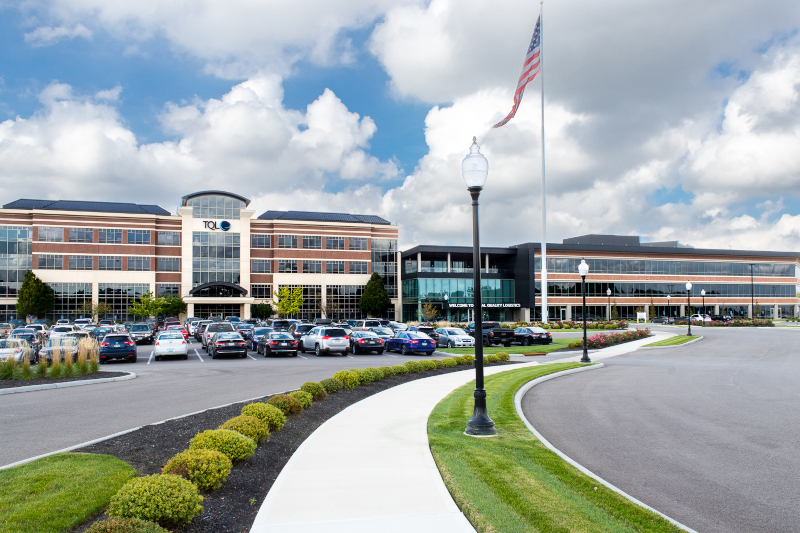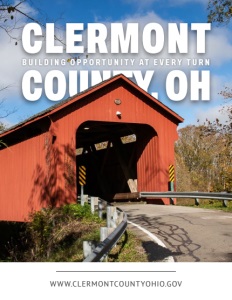Clermont County, Ohio
Building Opportunity at Every Turn
Making strides into its future with bold infrastructure investments and innovative partnerships.
Clermont County, Ohio, located in the state’s southwestern corner, blends the charm of rural life with the benefits of suburban development. With its population growing steadily over the past decade—surpassing 228,000 in recent estimates, this county offers an increasingly appealing mix of recreational opportunities, economic advantages, and proximity to Cincinnati. Positioned along 27 miles of the Ohio River, Clermont County provides access to water sports, vibrant town centers, and key transportation routes that drive its growth.
“Clermont County is one of the few counties in Ohio that’s seeing steady population growth,” says Commissioner David Painter. “We’ve got several features that make that possible. On the south side, you’ve got the Ohio River for boating and recreation, and then you move into our central region where State Route 32 connects us to Hamilton County and beyond.” He emphasizes the strategic advantage of Route 32, a four-lane highway stretching across the county without stoplights. “It’s a game changer for logistics companies like TQL, one of the world’s largest, and even for businesses like Nestlé Purina, which invested $550 million in a new facility here.”
Kris McClintick, Director of Community and Economic Development, adds to the picture, highlighting the county’s proximity to Cincinnati. “You can live here and be downtown at the Reds, Bengals, or FC Cincinnati stadiums in 20 to 25 minutes,” he explains. In addition, the Little Miami River, the Cincinnati Nature Center, and various parks make the area ideal for those seeking an active lifestyle. “We’ve got an outstanding outdoor recreation component here,” McClintick says, describing the surge in visitors and new residents who value the area’s natural beauty and opportunities for leisure.
Infrastructure and Economic Development
Clermont County’s growth story is deeply intertwined with its strategic investment in infrastructure. One of the county’s most ambitious initiatives is its push for high-speed internet access. McClintick outlines a $130 million investment by the state of Ohio and Alta Fiber (formerly Cincinnati Bell), paired with $5 million from the county itself. “We’re ensuring that every resident and business has future-proof access to high-speed broadband,” he says. “If people want to work from home or run a business, they’ll have the infrastructure to support it.”
Commissioner Painter ties this investment to broader economic incentives. “When you combine that connectivity with our 6.75% sales tax—lower than all the surrounding areas—it’s a very desirable place for people to live and businesses to invest,” he says. Again, high-pressure natural gas service is another recent game-changer. Painter highlights the Bethel-to-Batavia pipeline, developed in partnership with Duke Energy, which brought natural gas to previously inaccessible areas. “This isn’t just critical for residents—it’s a major driver for industrial development,” he explains. The pipeline extends into the Williamsburg Township area.
Economic development in Clermont County follows a collaborative model. Rather than dictating growth to individual townships, Painter explains that the county works with them to identify opportunities rather than dictating growth to individual townships. “Governments don’t create jobs—businesses do. But what we can do is create environments where competition and free markets thrive,” he says. One success story is Ivy Pointe, a commercial development near Eastgate and I-275. Initially backed by an $8.5 million county investment, the project attracted major businesses like TQL (Total Quality Logistics). “As TQL expanded and the acreage sold, the county got its investment back and reinvested in the next project,” Painter adds.

Economic Expansion
Positioning is everything when it comes to economic and commercial success. McClintick sees Clermont County as uniquely positioned for growth in the Cincinnati metro area. “When you look at Hamilton County and areas closer to Dayton, they’re mostly built out,” he explains. “Clermont County is where the developable land is now.” A prime example is the newly established Eastern Cincinnati Innovation Park, a 160-acre site near State Route 32. “We purchased the property in June and listed it in July,” he says. “We’ve already got two interested parties negotiating, which is remarkable when you consider that large sites like this often sit on the market for years.”
Beyond industrial sites, Clermont County is eyeing additional opportunities. “We’re undertaking a master planning study in 2025 to shape the future of economic development,” McClintick notes. The study will focus on trends and infrastructure needs, especially around State Route 32. “That’s going to be our industrial hub, but we also have tens of thousands of acres with development potential elsewhere,” he says. Among these opportunities are two retired coal plants, which the county is working to repurpose.
The county also sees potential in its general aviation airport. McClintick explains that a master planning study, funded partly by the FAA, is underway. “We believe the airport could be a much more valuable asset than it’s currently being used for,” he says, hinting at the county’s interest in attracting aviation-related industries or expanding regional transportation options.
Health, Growth, and Regional Connectivity
The rapid growth in Clermont County is mirrored in its expanding civic projects and collaborative infrastructure improvements. One of the crown jewels of Union Township’s development is the Cincinnati Children’s Eastgate facility. “It’s a 110,000-square-foot facility that’s going to house specialty clinics, outpatient surgery, and even a focus on breast cancer treatment for women,” says Painter. Scheduled to open in 2025, the hospital will serve Clermont County, eastern Hamilton County, and surrounding areas.
The county’s earlier success with Ivy Pointe set the stage for this wave of growth. What began as a vision for around 1,000 jobs has ballooned to an estimated 5,500 jobs, exceeding initial expectations. Painter recalls how this corridor evolved: “It stretches from TQL’s headquarters to a large printing manufacturer, a credit union’s corporate office, and now Children’s Hospital.” Ivy Pointe is a shining example of how public investment, like the county’s $8.5 million in initial funding, can generate returns and be reinvested in other critical projects.
Clermont County’s robust transportation planning supports this wave of development. At the core of this effort is the Transportation Improvement District (TID), which Painter describes as “one of the top state programs” for funding regional projects. The TID pools contributions from the county, townships, and external funding sources to ensure seamless project execution. The regional focus is critical, as Painter notes, “OKI was identified as the number one regional Metropolitan Planning Organization in the country, and our collaboration with them ensures Clermont is part of the broader transportation plan.”
Building Communities for Every Stage of Life
Clermont County is undergoing a housing boom occasioned by population growth and demand for diverse living options. Painter notes the scale of the expansion: “The Home Builders Association estimates that 9,000 new homes will be built in Clermont County over the next ten years.” For instance, in Batavia, two major projects are being implemented to transform the area. “One development is adding 850 homes,” says Painter. “Another, on 169 acres annexed by the village of Batavia along Airport Road, is planning to build close to 800 homes.” These projects include a mix of single-family homes and multifamily units.
McClintick talks about the growing importance of multifamily housing in Clermont County. “We’ve completed four or five deals this year that provide sales tax exemptions on construction materials for multifamily projects,” he explains. With single-family homes in short supply, demand for apartments, townhomes, and duplexes is rising rapidly. “Just in Union Township, the three or four projects we worked on are bringing more than 1,500 new multifamily units to the area,” he says.
For Clermont County leaders, it’s about more than just building homes—it’s about creating housing opportunities for residents at every stage of life. McClintick puts it plainly: “From a housing perspective, we want to provide stages of housing for every phase of life. Whether it’s a starter apartment, a family home, or a downsized condo for empty nesters, we’re making sure there are options.” This thoughtful approach ensures the county can retain residents as their needs and circumstances change, supporting a stable and thriving community.
Clermont County’s housing strategy is as much about foresight as it is about responding to current demand. With the region snowballing and Cincinnati’s urban areas nearing full development, Clermont is stepping up as the next frontier for residential growth. “Companies are approaching us regularly with plans for new housing,” says Painter. “The investment we’re seeing in single-family and multifamily developments is unlike anything we’ve seen before.”

Prioritizing Innovation, Workforce, and Business Growth
As Clermont County prepares for the next wave of development, its leaders are focusing on high-impact projects. The Eastern Cincinnati Innovation Park is at the forefront, a 160-acre site poised to be a magnet for businesses and auxiliary industries. McClintick identifies the park’s potential as a cornerstone of the county’s priorities. “This project could bring hundreds of direct jobs to the community, not to mention trucking and other support roles that will develop around it. It’s one of the most important projects we’re pushing in the next 18 months.”
A key piece of this strategy is workforce readiness. Commissioner Painter notes the importance of aligning educational resources with the county’s economic trajectory. “Having a workforce that is ready to meet the demands of increased development is critical,” he says.
To that end, Grant Career Center, located in Bethel, is building a new advanced manufacturing facility to prepare students for high-tech roles. “We need to nurture and support projects like this,” Painter adds, noting that a pipeline of skilled workers is essential for sustaining Clermont County’s growth. Working closely with the University of Cincinnati Clermont on workforce training and developing a pathway to the University of Cincinnati continue to be a key focus.
While large projects like Nestlé Purina and the Innovation Park often grab headlines, McClintick points out that smaller businesses are the backbone of the county’s economy. “Something like 85 to 90% of job growth comes from businesses already in the county,” he says. The county runs a robust business retention program in collaboration with Redi Cincinnati, a regional economic development initiative, to support these companies. “We work closely with our townships, villages, and cities to meet with businesses, understand their needs, and help them grow. It’s not always the big, shiny projects—it’s the smaller ones, like adding 20 jobs here or building a 200,000-square-foot addition there, that collectively drive our success.”
This approach is evident in the story of Hamilton Safe, a company that recently consolidated 300 jobs in a $17 million facility on Round Bottom Road. Painter explains how the county’s collaborative problem-solving helped make it happen. “They came to us with an issue—they needed infrastructure improvements, specifically a sewer line that had to go under a railroad. We teamed up with Union Township and got it done. The county handled the sewer project, Union Township used TIF agreements to reinvest in infrastructure, and now Hamilton Safe has a state-of-the-art facility here. Those 300 jobs are secure for decades.”
From large-scale innovation parks to the tailored support of smaller businesses, Clermont County’s priorities are grounded in generating growth at every level. As Painter puts it, “This is how it works: we listen, we partner, and we invest in solutions that keep jobs and opportunities right here in Clermont County. These are the kinds of efforts that will shape the next 50 years.”
AT A GLANCE
Clermont County
What: A growing hub for business, infrastructure development, and community growth
Where: Ohio State, USA
Website: https://clermontcountyohio.gov/
PREFERRED VENDORS
UC Clermont College – www.ucclermont.edu
UC Clermont College is in Clermont County on 91 beautifully wooded acres in Batavia Township. The college is an accredited, open-access institution offering more than 60 programs and degrees. UC Clermont is part of the nationally recognized University of Cincinnati. For more information, call 513-556-5400 or visit the website above.
Clermont County Convention & Visitors Bureau – https://discoverclermont.com/
The Clermont County Convention & Visitors Bureau is a professional destination marketing and sales organization, whose mission is to strengthen the community by generating economic growth and vitality through tourism, overnight stays and encouraging visitor spending in the local tourism economy.
MSP Design – mspdesign.com
MSP Design is a Cincinnati-based design firm with a dynamic team of professionals including architects, engineers, interior designers, landscape architects, planners, and surveyors. A steadfast dedication to quality has been the cornerstone of our past and is the foundation for our future.







